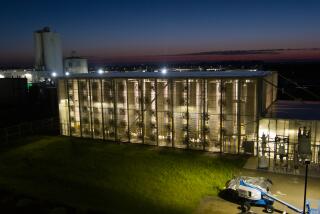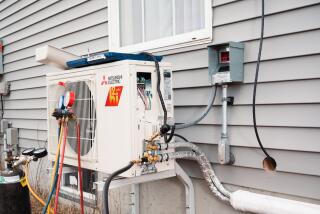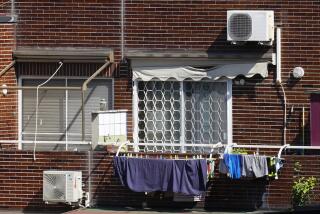4-in-1 Device Controls Home’s Climate
- Share via
“The only trouble with this machine is that it’s almost embarrassingly too simple!”
Jerry Federico, national sales manager for American Solar King Corp. of Waco, Tex., was talking about his company’s Energymaster air conditioning system that uses solar energy to heat, cool and ventilate a house or building as well as heating domestic water though, as increasing energy consciousness leads to increased “tightening up” of homes to keep the warm air or the cool air either in or out of the house, depending on the season.
Experts point out, quoting studies, that too tight a house can be unpleasant and even unhealthful. It’s not only that a tightly enclosed house can feel stale but it can actually smell--everything from the lingering (though originally pleasant) odor of the bacon fried for breakfast to bathroom smells or the unpleasant and unhealthful smell and presence of formaldehyde from processed wood in furniture, cabinets and floors.
The Energymaster’s basic function is heating and cooling. Air drawn from outside is first dried, then cooled twice--the second time in an evaporative cooler to reintroduce the right amount of moisture--and then sent into the house. Meanwhile, the house’s interior air is drawn out through the same mechanism and blown outdoors.
When cooling, the air is drawn into the house and passed through one half of a “desiccant wheel,” filled with a silica gel and revolving slowly. It then passes through half of a heat-exchanger wheel, which pre-cools it before it goes through the evaporative cooler, which moistens it the proper amount.
On its return, the air from the house flows first through the other half of the heat exchanger wheel, cooling it by picking up its heat, then is further heated in a solar coil and passed through the other half of the desiccant wheel, regenerating it by drying, and then is exhausted outside.
(A model--Energymaster II--that omits the drying function is available for extremely dry areas, basically, those above 700 feet. In the greater Los Angeles area that would mean most of the San Fernando and Antelope valleys and parts of Beverly Hills and the Hollywood Hills.)
When the system is used for heating, the incoming air is warmed by a solar coil after passing through the two wheels before it is introduced to the house. The whole thing is controlled by a thermostat.
If neither heating nor cooling is wanted, a switch on the thermostat turns off all the mechanism except the fans. In any of these modes, the air in a 2,000-square-foot home will be completely removed and replaced about five times an hour, Federico said.
The system normally consists of the proper number of 4-by-8-foot rooftop solar collectors, a 200-gallon stainless steel storage tank for air heating and cooling, another tank, 120 gallons, for domestic hot water, a gas backup heater for cloudy days and the Energymaster unit itself.
The Energymaster unit is bulky, about 4 by 4 by 7 feet, and is placed outside in the side or back yard. That has the further advantage of putting the fans outside the house, minimizing noise.
The fans are powered by one-third horsepower motors. The desiccant wheel turns two to three times an hour, the heat exchanger wheel four or five times a minute; each is powered by a one-twentieth horsepower motor (about like those in electric trains). It can be plugged into a standard 110-volt outlet.
For an 1,800-to-2,400-square-foot house, electricity use is 1,400 watts or about 13 cents an hour, Federico said, compared to conventional air conditioners’ cost of 34 cents an hour or more.
The installed cost of the unit would be in the neighborhood of $14,000 to $18,000, Federico said, adding that federal and state tax credits could return half or nearly half that to the buyer while energy savings would give a payback period of about three years.
A demonstration model is operating at the offices of Solar Unlimited Inc., 52 E. Magnolia Blvd., Burbank, the manufacturer’s Southern California distributor. In business since 1979, the firm was described by J. Robert Dominguez, president, as a solar contractor, designing, selling and installing solar systems for swimming pools, domestic hot water and other uses--such as the Energymaster interior climate controllers.
The firm has installed more than 1,500 solar systems in Southern California, Dominguez said, including an apartment complex in Redlands, Glendale’s Municipal Services Building and two fire stations, and a swimming pool heater at Crystalaire Country Club in Pearblossom.
He added that an Energymaster system (formerly known as Sunaire) has been in operation in La Habra since October, 1984, yielding a 60% to 80% cut in energy costs.
More to Read
Inside the business of entertainment
The Wide Shot brings you news, analysis and insights on everything from streaming wars to production — and what it all means for the future.
You may occasionally receive promotional content from the Los Angeles Times.










